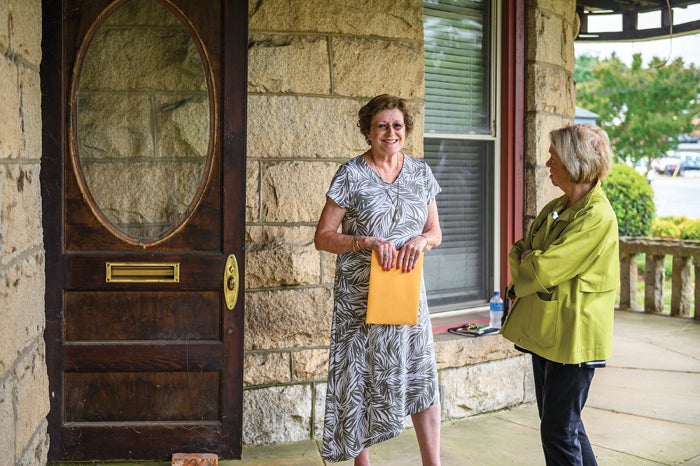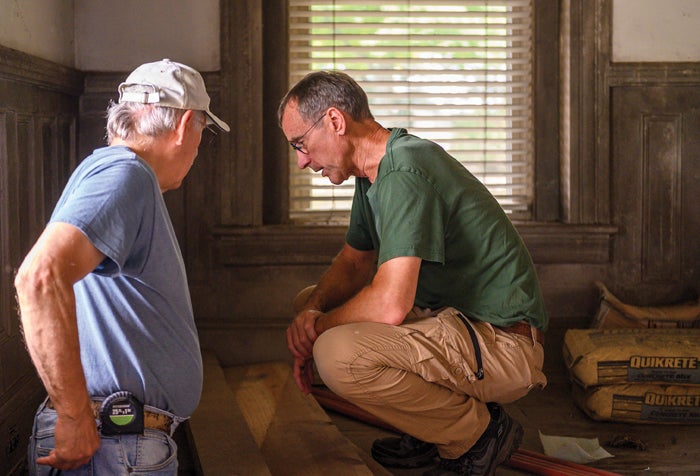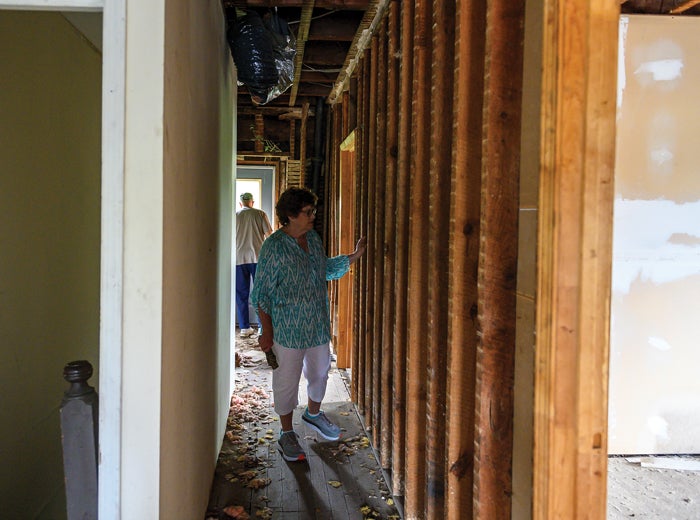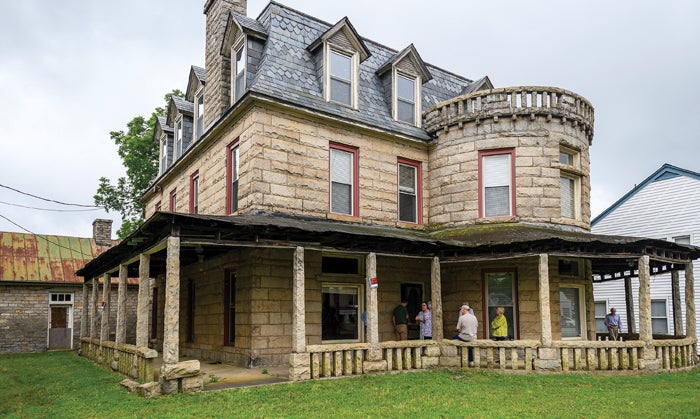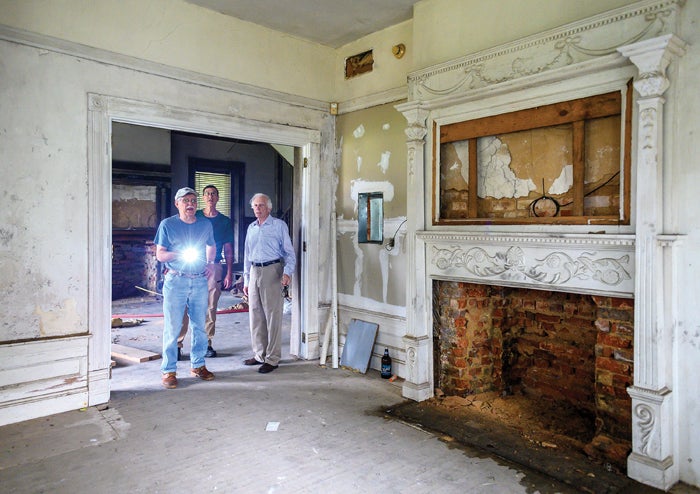Historic Salisbury Foundation becomes proud owner of Napoleon Bonaparte McCanless House
Published 12:10 am Thursday, June 20, 2019
SALISBURY — With a name such as Napoleon Bonaparte McCanless, you’d expect a man to have a house like this.
The bold granite exterior. The 15 spacious rooms spread over three floors. The steep mansard roof, punctuated by numerous dormers. The two-story tower topped by a granite balustrade. The handsome structure in back that was the original kitchen.
Long a conversation piece for both its majesty and neglect, the Napoleon Bonaparte McCanless House at 619 S. Main St. has a new owner.
Historic Salisbury Foundation bought the property for $160,000 from Livingstone College, completing the deal a week ago.
Susan Sides, president of the HSF board of trustees, unlocked the front door and gave a small group of fellow board members their first look at the house Wednesday morning.
The foundation’s immediate goals are a new roof and keeping out vagrants. Since the purchase was completed June 13, Sides says she has called police twice to remove people who were trespassing.
A massive cleanup also will be required before restoration work begins.
“I think we will remove the debris but leave the ghosts,” said Ed Clement, a noted Salisbury preservationist and one of HSF’s founders.
The 1897 house requires serious attention. Throughout various parts of the house — which was Bonaparte’s restaurant some 30 years ago — floor boards, plaster and drywall are missing.
“I remember sitting up here several times,” HSF board member Anne Lyles said in one of the upstairs rooms, which was in terrible shape.
Insulation is gone or scattered in clumps around the house. Bird droppings are evident. Heating and air-conditioning ductwork droops from ceilings. Doors are off their hinges and propped against walls.
“This top banister is loose, so be careful of that, ” Sides told the others as she reached the second floor.
It’s hard to believe this landmark, once restored for the restaurant and included on the National Register of Historic Places, could have deteriorated this much over the past two decades.
From a preservation standpoint, it’s back to square one.
“You just keep starting over,” said Nancy Clement, Ed’s wife and a fellow HSF board member.
But Ed Clement said an engineer considers the house to be structurally sound, and Clement was impressed Wednesday with the two-brick thickness of some of the walls, the wide floor joists and relatively good condition of much of the interior woodwork and the solid granite facing outside.
“I’m just amazed the mantels are still here,” Nancy Clement said.
The unique granite columns for the front porch are surprisingly intact, though the granite balusters are missing in a corner.
Rich Dietrich and Neil Buehrer are part of the volunteer team (Black’s Brigade) who usually descend on a newly acquired HSF property and do the work necessary to stabilize things and make it weathertight before someone takes on the true restoration.
They took a quick look at the house Wednesday, and Dietrich said the brigade has seen worse. Steve Cobb leads Black’s Brigade since Doug Black’s death, and Sides said he’s excited about getting started.
“Steve Cobb said to me, ‘This is like Christmas morning,'” she said.
Sides expects the property will return to commercial use, not a single-family home.
Clement said he hopes the house’s return to prominence can spark a revitalization on South Main Street the way the foundation’s restoration of Salisbury Station did for its section of town.
Clement said it’s one of four important houses left on South Main Street, a once proud residential street that long ago fell victim to commercialization and is a tired entrance coming into the downtown.
By contrast, Napoleon Bonaparte McCanless was an energetic man who at his death on Jan. 27, 1920, was described in a Salisbury Evening Post obituary as “a great builder” and “doubtless identified with more enterprises than any other man of this county of any age.”
Between at least 1891 and 1917, McCanless had a hand in the organization, funding and building of “an extraordinary number of ventures,” the National Register of Historic Places nomination says.
“Typical of entrepreneurship of the time, most of McCanless’ ventures included other investors and/or partners, but mostly it was McCanless who had the vision and know-how to guide the projects to success,” the National Register said.
The industrial enterprises McCanless was directly involved with included the Vance Cotton Mill, Kesler Cotton Mill, North Side Cotton Mill, the Doggin (or Coggin) Mines Co., Yadkin Finishing Co. and Harris Granite Co.
On the more commercial side, McCanless ventures included Salisbury Savings Bank, Peoples National Bank, a Morris Plan Co. Bank that would become Security Bank and Trust, the Washington Building on North Main Street, Central Hotel and the Empire Block and Hotel.
Then there was the residential side. Historians credit McCanless with concentrating on the southern end of Salisbury, where his own house was built.
He laid out Thomas Street and built several other houses. He macadamized some of Salisbury’s streets, and he was involved with Salisbury’s streetcar system through the Salisbury Electric Light and Street Railway Co.
He also had interest in the Spencer Street Railway and the Salisbury-Monroe Railroad.
“Much of Salisbury of today is due in very large measure to Mr. McCanless’ activities and interest,” the Salisbury Evening Post obituary said. “Manufacture, farming, mining, quarrying, banking and other activities owe much to his guiding hand and wisdom.”
As for McCanless’ house at 619 S. Main St., the National Register says it served as his residence “throughout most of his productive years” until his death.
“The Architecture of Rowan County,” by Davyd Foard Hood, describes the house as a Second Empire stone house, which is perhaps the only domestic example of the style rendered in stone in North Carolina.”
“The architectural character of the house reflects McCanless’ prominent role in the community as well as his ties to the local granite industry,” the National Register added.
On Sept. 13, 1897, the Evening World newspaper in Salisbury reported, “Work on Mr. N.B. McCanless’ stone residence on South Main Street has been suspended until next Monday owing to the exhaustion of granite on hand. By next Monday, Mr. McCanless hopes to have six carloads of granite … which will be sufficient to complete the building.
“This will be one of the handsomest homes in the state when completed, being built solely of Rowan granite.”
There’s a sad side to the house’s story.
McCanless’ widow, Georgia, lived in the house until her death in 1940. But in 1932, she did not have the funds necessary to satisfy a creditor, the National Bank and Trust Co.
Her house and lot were sold by the sheriff to the bank, which allowed her to live her remaining years in two rooms and a bath on the first floor.
Subsequent owners were R.E. Gambrill and his wife, who later leased it out in the 1960s as a nursing home. The building was vacant many years before Jo Ann Bennett and Kim Major of Kannapolis restored it in 1985-86 and ran Bonaparte’s until 1988.
Rowan Homes bought the property in 1991 and made it a home for developmentally disabled adults. Livingstone College later became the owners, eyeing the property as a possible home for its culinary school, now at the old Holiday Inn.
Over the years, Sides said, “I’ve had so many people ask, ‘Why don’t you do something about that house?'”
The simple answer always was that the foundation didn’t own the property, she said.
Now it does, and Sides sees it as a compliment when people expect the foundation to act when they see a historic property in trouble.
Sides already is thinking the foundation’s move to rescue the Napoleon Bonaparte McCanless House will have the same kind of impact as its saving of the Fulton-Mock-Blackmer House on South Fulton Street.
Going through the house Wednesday, one of the visitors said the house had the potential to be spectacular again — as big as the name behind it.
“It is going to be,” Sides promised.
Contact Mark Wineka at 704-797-4263 or mark.wineka@salisburypost.com.


